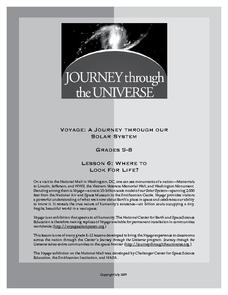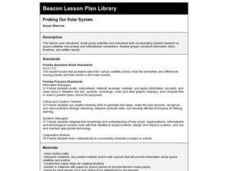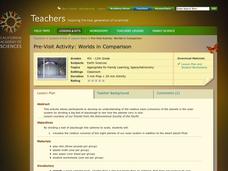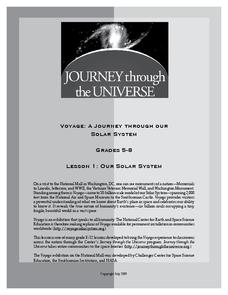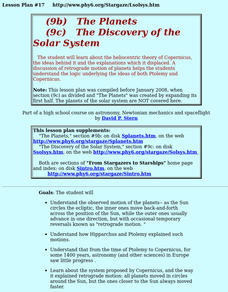Alabama Learning Exchange
Scaling Down the Solar System
Learners work collaboratively to gain a better understanding of the vastness of space by scaling down the solar system. They measure by inches, gain an understanding of space, and model the distances of the planets from the sun.
Curated OER
The Outer Planets
Young scholars study the planets Saturn, Uranus, and Neptune. In this solar system lesson plan, students read facts about the planets and their location in the solar system. Images, diagrams, and background information on the planets is...
Curated OER
Redesign the Rover: Mars Research Year-Round
Pupils discuss the solar system, the planets, periods of orbit and revolution. In this space lesson students discuss the importance of the study of Mars and brainstorm ideas on how NASA might solve its Rover design problem.
Journey Through the Universe
Where to Look For Life?
Every year we discover new planets including more than 1,000 in 2016 alone. Will we ever find life on another planet? The activity includes two activities to help scholars understand this concept. First, they analyze the temperature...
Laboratory for Atmospheric and Space Physics
Planetary Distances on the Playground
There's no need to stay inside; get out of the classroom and create a scaled map of the solar system on your playground field! In collaborative groups, scholars identify the distance between the sun and other planets, place planet...
Curated OER
Space and Science Fiction
Use the Franklin Institute's exhibition "An Inquirer's Guide to the Universe" to have students research ideas for a science fiction story. After completing their research, writers will compose science fiction stories that incorporate...
Curated OER
Blazing Gas
Fourth graders read and discuss the sun and the energy we use on Earth from the sun. In this sun lesson plan, 4th graders discuss the solar system, planets, and answer short answer questions.
Curated OER
Probing Our Solar System
Third graders engage in a instructional activity utilizing small group activities and individual work incorporating student research on space satellites, probes and international connections. They, in groups, construct information disks,...
Curated OER
Planets in Our Solar System
Fifth graders are introduced to the various planets, stars and moons in our solar system. Using photographs, they place the planets into the correct order from the sun. In groups, they research one planet, create a fact sheet and make...
Curated OER
Earth: Our Big Blue Marble
Students investigate Earth and its resources. In this Earth, space, and nature lesson plan, students collaborate to design presentations on the Earth, its cycles, and how humans have impacted the planet. Images, diagrams, and background...
Curated OER
Nine Planets
What are characteristics of a planet? With this plan, learners investigate the characteristics of the planets in our solar system. They gather research of the nine planets by using the Internet and other research tools. Then they create...
NASA
Dark Matter NASA Conference
Young scholars calculate the escape velocity of planets in our solar system and use that knowledge to calculate the escape velocity for NGC 2300 group. They then suggest reasons for the escape velocity to be higher than possible given...
Curated OER
Wish You Were Here
Pupils work in small groups to research information about planets in the solar system. They create picture postcards from space, drawing images they imagine they would see while traveling to a planet. They then write personal messages...
Curated OER
Solar System
Students analyze theories on how the solar system was formed. In this solar system lesson students explain the rotation and revolution of motion.
Curated OER
Space Science: Journey Through the Solar System
Students explore the Solar System and examine the characteristics of al the planets. Through research and discussion, they create catalogs of the Solar System's components. Next, students use their findings to create Powerpoint...
University of Colorado
Modeling Sizes of Planets
The density of the huge planet of Saturn is 0.7 g/cm3, which means it could float in water! In the second part of 22, science pupils explore the size and order of the planets. They then calculate weight and/or gravity and density of...
Scholastic
Lesson One: The Earth, Background and Glossary
How much do you really know about our planet? Middle schoolers build up their prior knowledge about Earth, its placement in the solar system, its composition, and important geological vocabulary with an introductory earth science lesson.
Pacific Science Center
Worlds in Comparison
Young astronomers follow a step-by-step procedure for dividing a lump of dough into parts, resulting in a scaled volume set of puny planets. Along with the printable directions is a template chart of planet names on which learners can...
Curated OER
Solar System
Second graders create planet mobiles in order to reinforce concepts such as planet size, position in relation to the sun, and planet names.
Curated OER
Solar System: The Four Inner Planets and Earth's Moon and Astronauts
Second graders read THe Magic School Bus: Lost in the Solar System. For this language arts and science lesson, 2nd graders explore the four inner planets. Students view the inner planets using Google Earth.
Curated OER
The Solar System
Students study the planets of the solar system. Students observe a model of the solar system, and name each planet, in order. In pairs, students write acronyms to assist in remembering the plants in order and share them with their...
Curated OER
Our Solar System
Students explain the classification of planets according to various criteria. They create charts illustrating comparative data.
Curated OER
Solar System: Fantasy Planet
Students create their own fantasy planet using computer software on KidPix. In this planets lesson plan, students also write a paragraph about their planet including the name, population, weather, and more.
Curated OER
The Discovery Of The Solar System
Students study the heliocentric theory of Copernicus, the ideas behind it and the explanations which it displaced. A discussion of retrograde motion of planets helps students explain the logic underlying the ideas of both Ptolemy and...



